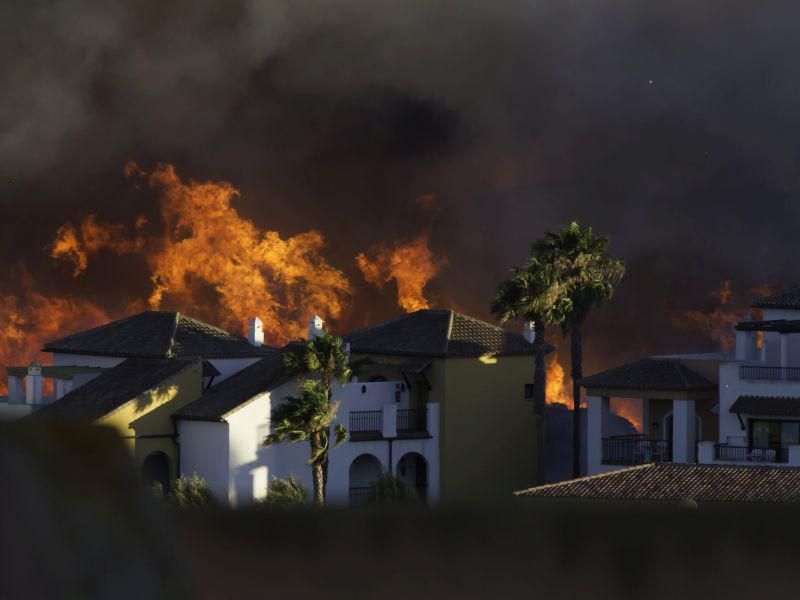TUESDAY, March 23, 2021 (HealthDay News) — The smoke from forest fires is sending children to emergency rooms with respiratory problems at higher rates than ever before, a new study finds.
“Kids are particularly vulnerable to pollution from wildfires, so they can have asthma exacerbation and other respiratory problems,” said senior researcher Tarik Benmarhnia, an associate professor of family medicine and public health at the University of California, San Diego.
Even small wildfires produce fine particle pollution, called PM2.5, at levels higher than those usually seen from traffic or other sources of combustion. Moreover, the pollutants from fires are more toxic, because they are produced at higher temperatures, Benmarhnia explained.
“Toxicological studies in the last few years found that when smoke is generated at really high temperatures, which is the case for wildfires, as compared to other sources of emission like traffic, oxidative stress will be higher, which is the capacity for these particles to damage lung function,” he said.
Benmarhnia noted that because children’s lungs are still developing, they may be more susceptible to damage from air pollution.
For the study, Benmarhnia and his colleagues collected data on visits to emergency and urgent care facilities in San Diego County of patients age 19 and younger with respiratory conditions, including difficulty breathing, respiratory distress, wheezing, asthma or cough. The study period covered 2011 to 2017.
They found that non-wildfire pollution increased emergency room visits among children for respiratory problems by nearly 4%, compared with the 30% increases attributed to wildfire pollution.
“What we concluded from this study is that there is no safe level of pollution,” Benmarhnia said. “Lower levels have less impact, but any level of pollution is associated with this increase in risk.”
The danger from wildfire pollution is expected to increase as climate change triggers more fires, he said.
“Unfortunately, this is what to expect in the next few decades, and most of the pollution problems that we’ll have in California will be coming from wildfires and not from traffic, as it used to be,” Benmarhnia said.
The best advice to avoid wildfire pollution is to keep kids indoors with the windows closed and with an air conditioner or air filtration device going, he said.
Benmarhnia thinks that wearing face masks may be advisable. That might be easier, because COVID-19 has made wearing masks the new norm.
“I think that would be a good, a nice initiative for doing that in schools,” he said. “Whatever happens, we just need to be ready to adapt to that instead of being surprised, because this is, unfortunately, the new reality.”
Dr. Meredith McCormack, medical director of the Pulmonary Function Laboratory at Johns Hopkins University in Baltimore, wasn’t part of the study, but reviewed the findings. She believes that pollution from wildfires will get worse and could affect children’s respiratory health well into adulthood.
“We anticipate that we’ll be seeing more of the fires, and we know that what happens in childhood also can set the tone for your risk of chronic lung disease as an adult,” McCormack said.
Childhood asthma is a risk factor for developing chronic lung disease, and having more exposure to air pollution during childhood is a risk factor for having lower lung function and worsening asthma, she said.
McCormack also noted that wildfires aren’t confined to California, but are becoming more common throughout the country.
Pollution from wildfires might also make children more vulnerable to other respiratory infections, she said.
Growing evidence suggests that air pollution is a risk factor for COVID-19 and other viral infections, McCormack said.
“I think it’s another factor why people are more in tune with what they can do to protect their lung health, and certainly, as we think about ways to minimize the risk of COVID, particularly for kids who don’t yet have vaccine and who may be more susceptible,” McCormack said. “Air quality is a good example of something that we can try to improve.”
Like Benmarhnia, McCormack advises people to take steps to protect themselves and their children from the toxic pollution produced by wildfires.
“Make sure to check ventilation systems and have good air conditioning filters and also portable air cleaners,” she said. “Also, closing windows and having air purifiers is a way that you can try to improve the quality of the air in your home.”
The report was published online March 23 in the journal Pediatrics.
More information
For more on wildfire pollution, see the American Lung Association.
SOURCES: Tarik Benmarhnia, PhD, associate professor, Family Medicine and Public Health, University of California San Diego; Meredith McCormack, MD, medical spokeswoman, American Lung Association, and medical director, Pulmonary Function Laboratory, Johns Hopkins University, Baltimore; Pediatrics, March 23, 2021, online
Copyright © 2025 HealthDay. All rights reserved.

